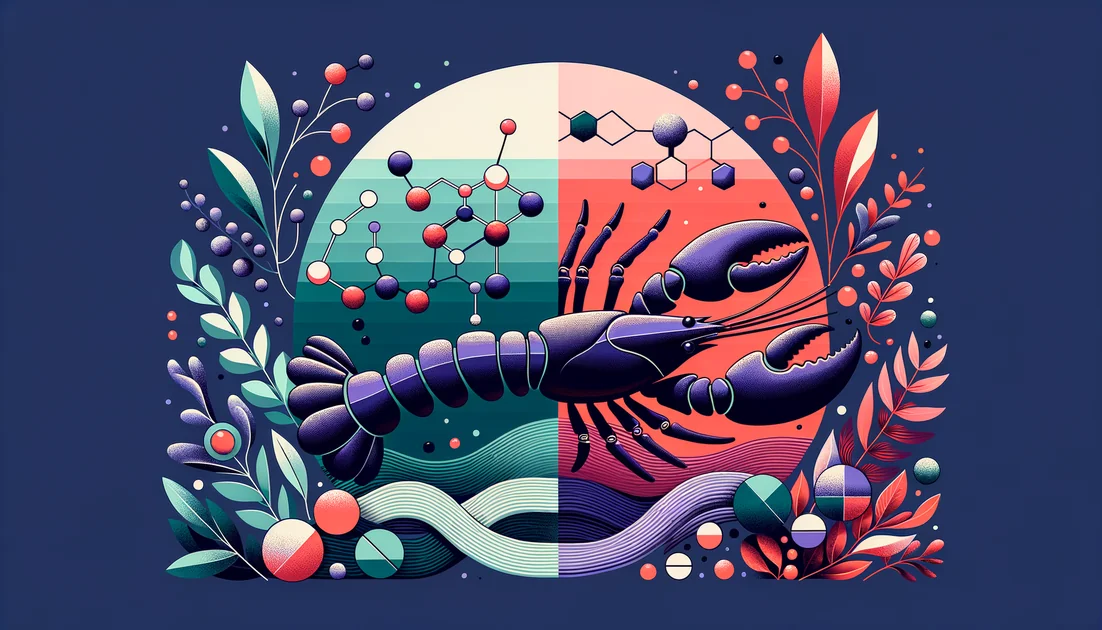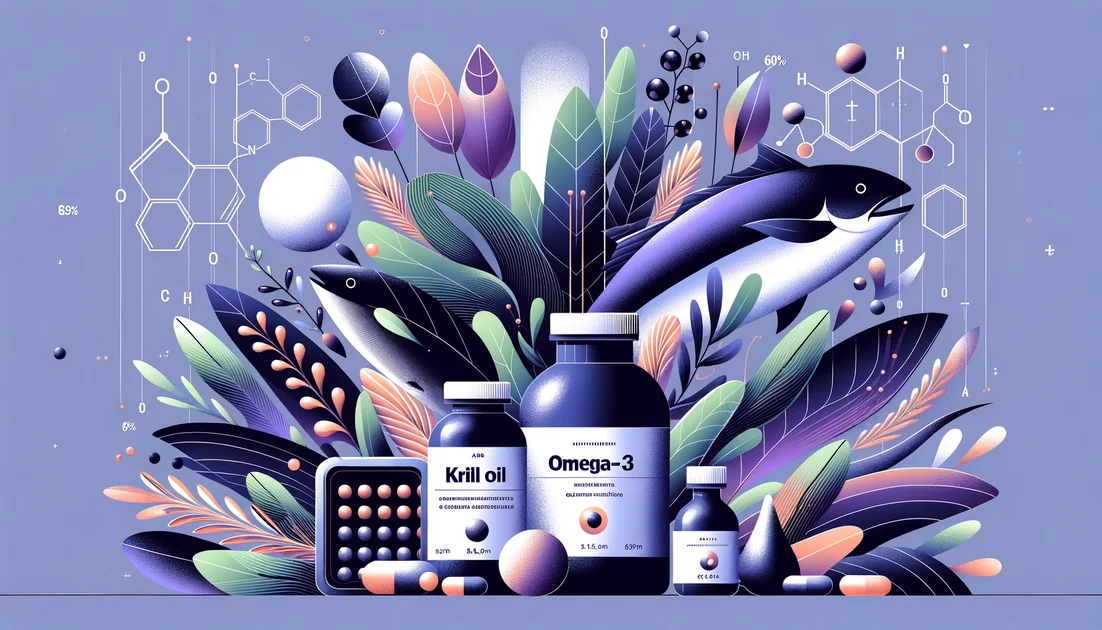
From Blue Lobsters to Sun-Safer Skin: How a Sea Pigment Became a Modern Health Tool
A lobster drops into a pot and, in seconds, its shell flashes from blue-green to fire-red. That dramatic color flip is your first glimpse of astaxanthin—the same pigment now showing up in capsules that promise calmer skin under summer sun and steadier eyes after hours of screen glare.
- Evidence
- Promising
- Immediate Effect
- No → 6-12 weeks
- Wears Off
- Gradually over weeks after stopping
The moment the lobster turns red
Cooks noticed the trick long before chemists did: living lobsters wear a blue-green coat, but heat their shells and crimson bursts forth. The mystery unraveled when researchers showed that a shell protein, crustacyanin, clamps the red pigment astaxanthin into a twisted shape so it looks blue; heat loosens the grip and the true red returns. "When astaxanthin is free, it's red. When it's bound to crustacyanin, it turns blue," biochemist Michele Cianci explained—like letting a twisted rubber band snap back to form. [1][2]
The pigment that paints the sea
Astaxanthin isn't just culinary theater. In the 1930s, chemists traced lobster and salmon hues to this xanthophyll and even coined its name from Astacus, the old genus for European lobster. Later work mapped how a stress-tough microalga, Haematococcus pluvialis, stockpiles astaxanthin—turning itself brick-red to weather harsh sun—making it the richest natural source for supplements today. [3]
From feed bins to pill bottles
Here's the paradox: farmed salmon are grayish without astaxanthin in their feed. Producers add it—often from algae—to restore the wild pink consumers expect. The same molecule that sells salmon now shows up in human trials for skin, eyes, and performance. [4]
Skin: building shade from the inside
Dermatology's classic yardstick for sun sensitivity is the minimal erythema dose (MED)—the UV energy that gives you a faint, first-degree sunburn. In a 10-week randomized, placebo-controlled trial, 4 mg/day of algal astaxanthin increased MED and reduced post-UV moisture loss, suggesting skin was harder to redden and better at holding water. Participants also reported smoother texture. [5] A systematic review of human trials echoed pieces of that picture: pooled data suggest improvements in skin moisture and elasticity, though wrinkle changes were inconsistent and many studies were small. [6] In other words, it's not a tan in a pill; it's more like upgrading the skin's internal sun buffer.
"It is a powerful antioxidant which protects against damage from cell membranes and tissues," noted Professor Naomi Chayen when that lobster color secret first hit the headlines—an apt metaphor for how the molecule behaves in skin. [7] And despite social-media myths, experts caution astaxanthin doesn't promote tanning; if anything, by dampening overactive pigment signals it could blunt some tanning responses. [8]
Eyes: the screen-staring experiments
If you've felt your focus blur after a spreadsheet marathon, you're not alone. In a randomized trial of healthy adults, 9 mg/day for six weeks helped people over 40 maintain visual acuity after a standardized visual-display-terminal (VDT) task—less end-of-day blur versus placebo. [9] An 84-day pediatric trial in heavy screen-using schoolchildren (4 mg/day) found bigger steps: computer-vision-syndrome scores dropped, kids reported less visual fatigue, and some objective measures like stereopsis and light reflex improved. [10] Other combinations (astaxanthin with lutein/zeaxanthin or tocotrienols) have also shown VDT-related benefits, though combos make it hard to credit one ingredient. [11][12]
Endurance: chasing a small edge
Athletes noticed wild salmon's long migrations and wondered if the pigment that colors their flesh also guards human muscles under strain. In cyclists, 28 days of 4 mg/day improved a 20-km time trial and power output versus placebo in a small but well-controlled study. [13] A separate crossover trial found that just seven days of 12 mg/day trimmed about 1% off a 40-km time trial—tiny for daily life, meaningful at the pointy end of racing. [14] Not every marker moves: four weeks at 20 mg/day didn't blunt exercise-induced cardiac troponin release, a stress signal after hard rides. [15] Translation: performance gains appear possible but modest and not guaranteed.
Fertility: a cautionary detour
Early, small work in male infertility hinted at improved sperm motion and lower oxidative stress with 16 mg/day. [16] But a larger, rigorous trial in men with oligo-astheno-teratozoospermia saw no changes in semen parameters. [17] A recent post-surgery study in men treated for varicocele tracked favorable shifts in antioxidant gene expression with astaxanthin, but clinical endpoints remain unsettled. [18] For now, this path is intriguing, not proven.
How does a pigment do all this?
Think of astaxanthin as a double-ended safety pin that latches into cell membranes. There it quenches reactive byproducts of light, oxygen, and exertion—helping skin keep its barrier after UV, eyes keep their precision under screen glare, and muscles keep their power plants tidy during long efforts. Meta-analyses show small reductions in oxidative stress markers and C-reactive protein, especially at higher doses and longer durations—biochemical hints that match the clinical stories above. [19][20]
Putting it to use (without the hype)
Dose and timing: Most skin and eye trials used 4–12 mg/day for 6–12 weeks. Take it with a meal containing fat; human pharmacokinetic studies show significantly higher and steadier blood levels that way. [21][22]
Quality matters: Natural algal extracts are mostly esterified forms and specific stereoisomers; different formulations (including micellar or sustained-release) can boost absorption. [23][24][25]
Safety: Europe's food-safety authority considers up to 8 mg/day from supplements safe for adults, accounting for seafood in the diet. That same intake can exceed the acceptable daily intake in children and younger teens, so adult-strength products aren't for kids. [26]
What the story suggests now
From a lobster's camouflage to a cyclist's stopwatch, astaxanthin's arc is a reminder that nature's colors can do more than please the eye. The most convincing human data sit in two camps: subtle skin photoprotection and support for visual performance under digital strain. Exercise and fertility findings are mixed and still unfolding. That doesn't make the molecule magical; it makes it interesting—worth trying if your days are heavy on sun or screens, and worth watching as better-designed trials sharpen the picture.
Where the trail points next
Researchers are probing whether specific forms—or delivery systems—put more pigment where it matters (think: cornea and retina, or deeper dermis) and whether endurance gains scale beyond small, trained cohorts. New extraction and formulation work aims to make the alga's stubborn pigment easier to absorb without mega-doses. [27][23] Meanwhile, one simple kitchen lesson endures: the same chemistry that turns a lobster red might, in careful doses, help your skin and eyes keep their cool under modern light.
[1]: Scientific American explained the color-shift mechanism via X-ray crystallography of beta-crustacyanin.
[2]: Live Science interview quoting Michele Cianci on astaxanthin's blue-to-red behavior.
[3]: Comprehensive historical and biological overview of astaxanthin's discovery and algal sourcing.
[4]: Reporting on farmed salmon's gray flesh without added carotenoids and industry use of astaxanthin.
[5]: Randomized trial: 4 mg/day raised MED and reduced UV-induced moisture loss over 10 weeks.
[6]: Systematic review/meta-analysis: moisture and elasticity improved; wrinkle effects inconsistent.
[7]: BBC News quote from Naomi Chayen on astaxanthin's antioxidant potency.
[8]: Trade-press expert comments clarifying that astaxanthin does not induce tanning and may limit it.
[9]: Adult VDT trial: 9 mg/day preserved post-task acuity in participants ≥40 years.
[10]: Pediatric RCT: 4 mg/day reduced digital eye-strain scores and improved select measures over 84 days.
[11]: Combination study (astaxanthin + tocotrienols) showing VDT-related acuity benefits in adults ≥40.
[12]: Combination study (astaxanthin + lutein + zeaxanthin) improving eye–hand coordination after VDT.
[13]: 28-day cycling study: faster 20-km time trial and higher power with 4 mg/day.
[14]: 7-day crossover: ~1% faster 40-km time trial with 12 mg/day.
[15]: 4-week RCT: 20 mg/day did not reduce exercise-induced cardiac troponin release.
[16]: Early RCT in male infertility suggesting improved motility/oxidative metrics with 16 mg/day.
[17]: Later double-blind RCT found no semen-parameter benefit in OAT men.
[18]: Triple-blind RCT after varicocele surgery: antioxidant signaling shifts with astaxanthin.
[19]: Meta-analysis: reductions in malondialdehyde (oxidative stress), particularly in T2D subsets.
[20]: Meta-analysis: small HDL-C rise; CRP reduction at higher dose/longer use.
[21]: PK study—taking astaxanthin with fats markedly increases bioavailability.
[22]: After-meal dosing increased exposure; smoking shortened half-life.
[23]: Newer micellar/sustained-release formulations improve absorption kinetics.
[24]: Review on stereochemistry/esterification shaping stability and uptake.
[25]: Animal data: Z-isomers showed higher tissue accumulation than all-E form.
[26]: EFSA opinion: up to 8 mg/day safe for adults; children/younger teens may exceed ADI.
[27]: Process innovations to extract astaxanthin from the tough-walled microalga more efficiently.
Key takeaways
- •Astaxanthin's sea-to-science story: a lobster-shell pigment that, when freed from proteins, reveals its potent red antioxidant character.
- •Human studies suggest higher UV doses are needed to trigger sunburn and post-UV water loss drops with oral astaxanthin, supporting 'sun-safer' skin.
- •Visual support: adults ≥40 kept clearer acuity after prolonged screen work, and kids reported less eye strain in trials.
- •Skin feel: daily use has been linked to improved hydration and elasticity over weeks, aligning with the article's primary benefits.
- •Dosing used in studies: typically 4–12 mg/day; plan 6–12 weeks for skin/eye goals; athletes tested 4 mg/day for 28 days or 12 mg/day for 7 days.
- •Absorption matters: take with a fat-containing meal; lipid or micellar formulas can yield 2–4× higher blood levels than fasting.
You might also like
Explore more of our evidence-led investigations, comparisons, and guides across every article style.

Puritan's Pride
Puritan's Pride: Industry-grade manufacturing meets discount pricing—so why is transparency still the weak link?

Fish Oil (EPA+DHA from fish oil) vs Krill Oil (Antarctic krill oil)
For most people seeking proven heart benefits or triglyceride lowering, choose fish oil (or prescription EPA) because outcomes data are strongest. Pick krill oil if you prefer smaller caps and potentially gentler GI feel, knowing EPA+DHA per capsule is usually lower. [4][6][1]


Vitamin K2
You load up on calcium for strong bones—then your heart scan shows calcium where it doesn't belong. What if a quiet vitamin acts like a traffic cop, waving calcium into bone and away from arteries?

Memory Stack With Real Clinical Data
Dual-core, theoretical synergy: both work on their own; together looks additive with plausible complementarity, but no direct human A+B head-to-head proof yet.

Tocotrienols
The stealthier cousins of vitamin E—built with springy tails that move differently in cell membranes and behave differently in your body.


